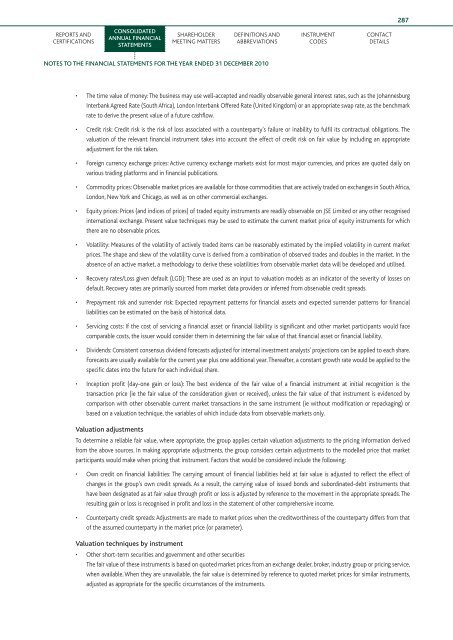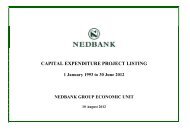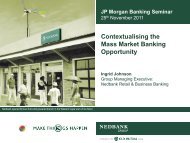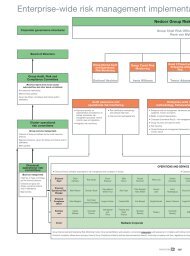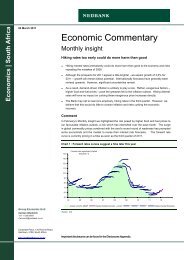Download the PDF (5.4 MB) - Nedbank Group Limited
Download the PDF (5.4 MB) - Nedbank Group Limited
Download the PDF (5.4 MB) - Nedbank Group Limited
You also want an ePaper? Increase the reach of your titles
YUMPU automatically turns print PDFs into web optimized ePapers that Google loves.
287Reports andcertificationsConsolidatedannual financialstatementsShareholdermeeting mattersDefinitions andabbreviationsInstrumentcodesContactdetailsnotes to <strong>the</strong> financial statements for <strong>the</strong> year ended 31 December 2010• The time value of money: The business may use well-accepted and readily observable general interest rates, such as <strong>the</strong> JohannesburgInterbank Agreed Rate (South Africa), London Interbank Offered Rate (United Kingdom) or an appropriate swap rate, as <strong>the</strong> benchmarkrate to derive <strong>the</strong> present value of a future cashflow.• Credit risk: Credit risk is <strong>the</strong> risk of loss associated with a counterparty’s failure or inability to fulfil its contractual obligations. Thevaluation of <strong>the</strong> relevant financial instrument takes into account <strong>the</strong> effect of credit risk on fair value by including an appropriateadjustment for <strong>the</strong> risk taken.• Foreign currency exchange prices: Active currency exchange markets exist for most major currencies, and prices are quoted daily onvarious trading platforms and in financial publications.• Commodity prices: Observable market prices are available for those commodities that are actively traded on exchanges in South Africa,London, New York and Chicago, as well as on o<strong>the</strong>r commercial exchanges.• Equity prices: Prices (and indices of prices) of traded equity instruments are readily observable on JSE <strong>Limited</strong> or any o<strong>the</strong>r recognisedinternational exchange. Present value techniques may be used to estimate <strong>the</strong> current market price of equity instruments for which<strong>the</strong>re are no observable prices.• Volatility: Measures of <strong>the</strong> volatility of actively traded items can be reasonably estimated by <strong>the</strong> implied volatility in current marketprices. The shape and skew of <strong>the</strong> volatility curve is derived from a combination of observed trades and doubles in <strong>the</strong> market. In <strong>the</strong>absence of an active market, a methodology to derive <strong>the</strong>se volatilities from observable market data will be developed and utilised.• Recovery rates/Loss given default (LGD): These are used as an input to valuation models as an indicator of <strong>the</strong> severity of losses ondefault. Recovery rates are primarily sourced from market data providers or inferred from observable credit spreads.• Prepayment risk and surrender risk: Expected repayment patterns for financial assets and expected surrender patterns for financialliabilities can be estimated on <strong>the</strong> basis of historical data.• Servicing costs: If <strong>the</strong> cost of servicing a financial asset or financial liability is significant and o<strong>the</strong>r market participants would facecomparable costs, <strong>the</strong> issuer would consider <strong>the</strong>m in determining <strong>the</strong> fair value of that financial asset or financial liability.• Dividends: Consistent consensus dividend forecasts adjusted for internal investment analysts’ projections can be applied to each share.Forecasts are usually available for <strong>the</strong> current year plus one additional year. Thereafter, a constant growth rate would be applied to <strong>the</strong>specific dates into <strong>the</strong> future for each individual share.• Inception profit (day-one gain or loss): The best evidence of <strong>the</strong> fair value of a financial instrument at initial recognition is <strong>the</strong>transaction price (ie <strong>the</strong> fair value of <strong>the</strong> consideration given or received), unless <strong>the</strong> fair value of that instrument is evidenced bycomparison with o<strong>the</strong>r observable current market transactions in <strong>the</strong> same instrument (ie without modification or repackaging) orbased on a valuation technique, <strong>the</strong> variables of which include data from observable markets only.Valuation adjustmentsTo determine a reliable fair value, where appropriate, <strong>the</strong> group applies certain valuation adjustments to <strong>the</strong> pricing information derivedfrom <strong>the</strong> above sources. In making appropriate adjustments, <strong>the</strong> group considers certain adjustments to <strong>the</strong> modelled price that marketparticipants would make when pricing that instrument. Factors that would be considered include <strong>the</strong> following:• Own credit on financial liabilities: The carrying amount of financial liabilities held at fair value is adjusted to reflect <strong>the</strong> effect ofchanges in <strong>the</strong> group’s own credit spreads. As a result, <strong>the</strong> carrying value of issued bonds and subordinated-debt instruments thathave been designated as at fair value through profit or loss is adjusted by reference to <strong>the</strong> movement in <strong>the</strong> appropriate spreads. Theresulting gain or loss is recognised in profit and loss in <strong>the</strong> statement of o<strong>the</strong>r comprehensive income.• Counterparty credit spreads: Adjustments are made to market prices when <strong>the</strong> creditworthiness of <strong>the</strong> counterparty differs from thatof <strong>the</strong> assumed counterparty in <strong>the</strong> market price (or parameter).Valuation techniques by instrument• O<strong>the</strong>r short-term securities and government and o<strong>the</strong>r securitiesThe fair value of <strong>the</strong>se instruments is based on quoted market prices from an exchange dealer, broker, industry group or pricing service,when available. When <strong>the</strong>y are unavailable, <strong>the</strong> fair value is determined by reference to quoted market prices for similar instruments,adjusted as appropriate for <strong>the</strong> specific circumstances of <strong>the</strong> instruments.


